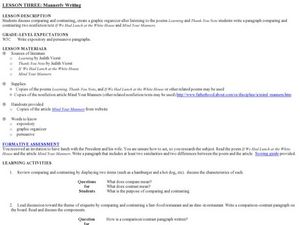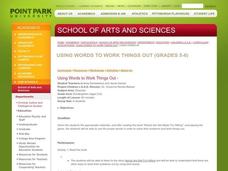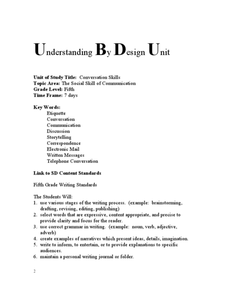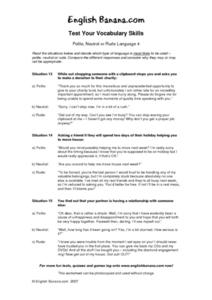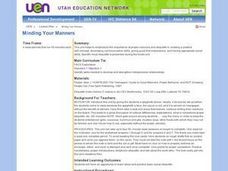Curated OER
Good Manners
It's never to early to introduce childen to good manners. It's often assumed that they will just "learn" them on their own, but that's not true! For this simple lesson, pupils practice using good manners and conversation skills at a...
Curated OER
Tissue, Please!
Students study the proper manners to reduce the risk of spreading or catching colds and flu. They discover good cold-season manners from reading aloud Tissue, Please! They complete an art project to reinforce good cold-season manner
Curated OER
A Place at the Table
Twelfth graders set up a formal table setting in their classroom. Individually, they identify the proper serving or eating utensil for the various courses of a meal. To end the lesson, they discuss and role-play proper table manners and...
Curated OER
Living With Rules
Young children explore the concept of the Golden Rule in this fun primary grade lesson. To begin, the class sings the song "The Lion and the Mouse" before discussing what the Golden Rule means and how it applies...
Curated OER
The Hidden Feast
Students identify the responsibilities of being a guest at a party and the kind of behavior that is expected at a special occasion. They develop a list of good party manners, then listen to the book "The Hidden Feast." Students then...
Curated OER
Mannerly Writing
Writers draft paragraphs comparing and contrasting the author's viewpoint in two poems. They also discuss the differences between an informational text and a poem regarding manners. Rubric and assessment are provided.
Curated OER
Graphing
In this graphing worksheet, 5th graders identify and graph 20 different problems on the 3 different graphs shown on the sheet. First, they use the tally of callers organized by the school to complete the three different types of graphs....
Curated OER
Manners and Etiquette Day 2
Practice correct table setting procedures and identify acceptable manners and etiquette skills to be used with meal service. Your class will practice table manners and introductions and create a real working atmosphere with customers....
Curated OER
Etiquette Lessons for Students
Young scholars explore the meaning of good manners and proper etiquette. In this behavior lesson, students read an article that explains manners in the social setting and workplace, then complete several activities that reinforce...
Curated OER
Using Words to Work Things Out
Students explore classroom community building. In this character development and community building lesson, students listen to Hands Are Not for Hitting and generate a class list of positive ways to handle classroom conflicts. Students...
Curated OER
Introduction to Formal English
Ninth graders brainstorm different situations in which formal English is used. Individually, they describe how people would act if they were invited to the White House for dinner and what they would do. To end the lesson, they role...
Curated OER
Positively Respectful
Create a positive environment by teaching learners to show respect and share compliments. Students use drawing paper and create a self-portrait. Learners are encouraged to discuss things they like about themselves. As students share...
Curated OER
Be a Manners Detective
Students fill out a sticker chart and identify behaviors for completing nice manners. In this nice manners lesson plan, students discuss behaviors that are nice.
Curated OER
Don't Let the Pigeon Drive the Bus!: Manners Discussion
Students have a class discussion about appropriate behaviors and manners. In this manner instructional activity, students read the book entitled Don't Let the Pigeon Drive the Bus! and discuss the events within the book. ...
Curated OER
The Social Skill of Communication
Fifth graders explore communication by analyzing manners. In this social skills instructional activity, 5th graders review the different forms of communication and how to present yourself in a phone conversation, face to face meeting,...
Curated OER
Chivalry
Eighth graders explore manners by writing short stories. In this chivalry code lesson plan, 8th graders identify the traits of chivalry and explore the history of chivalry in England. Students complete a chivalry worksheet and write a...
Curated OER
Perfect Manners/Roles of Citizens
Students discuss manners and citizenship. For this roles of citizens lesson, students read D.W.'s Guide to Perfect Manners and create a Venn Diagram with examples from the story. Students take a quiz.
Curated OER
Polite, Neutral Or Rude Language 4
In this language arts worksheet, 5th graders learn the difference between polite, neutral and rude responses to oral requests. Students read 3 situations and 3 possible responses. Students compare them and decide which is the most...
Curated OER
Polite, Neutral Or Rude Language- Introduction
In this language arts activity, students are introduced to the difference between polite, rude or neutral language. Students read the information paragraphs about when it is appropriate to use each type of language.
Curated OER
P.E. Bees
Students practice positive social skills and manners in this short lesson that is used to start each session of P.E. class. They identify a positive behavior, such as be on time, written on a bee cutout pasted among others on the gym...
Curated OER
Manners
Students investigate the concept of manners and how they should be exercised at school. This lesson is a foundation of classroom management for Physical Education and is meant to be adapted to other classes if needed. Students focus upon...
Curated OER
Value: Right Conduct Politeness
Students explore the positive aspects of being polite. They listen to a story and identify phrases that are examples of having good manners. Students sing a good manners song. Afterward, they play a ladder game and complete worksheets to...
Curated OER
Sharing Under the Sea
Students listen to story The Rainbow Fish by Marcus Pfister, discuss why sharing is good, demonstrate understanding of sharing by decorating and sharing cookies, and practice saying "please" and "thank you" as they share icing with other...
Curated OER
Minding Your Manners
Students practice basic social etiquette skills. They view a video, write a thank you note with an addressed envelope, eat a dinner and simulate introductions and phone conversations. They identify accepted manners and demonstrate them.







